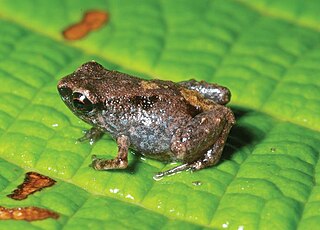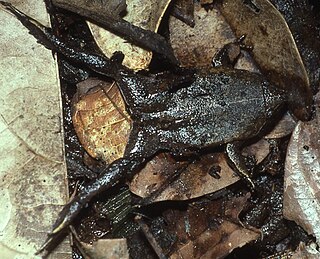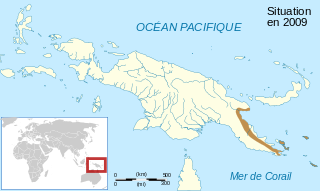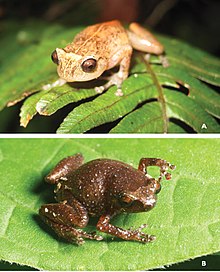
The Microhylidae, commonly known as narrow-mouthed frogs, are a geographically widespread family of frogs. The 683 species are in 63 genera and 11 subfamilies, which is the largest number of genera of any frog family.

Cophylinae is a subfamily of microhylid frogs endemic to Madagascar. It has over 100 species in eight genera. Members of this subfamily range from minute to fairly large, and they are highly ecologically diverse. DNA barcode research has revealed a significant taxonomic gap in this subfamily, and an estimated 70+ candidate species were identified. Many of these have subsequently been described, as well as numerous new discoveries.

Asterophryinae is a subfamily of microhylid frogs distributed in an area from the Peninsular Malaysia through the Malay Archipelago to northern Australia.

Barygenys is a genus of microhylid frogs. They are endemic to New Guinea and the adjacent Louisiade Archipelago. So far only known from Papua New Guinea, the range of the genus is expected to reach Papua province in the Indonesian part of New Guinea. Despite not being known from Papua, common name Papua frogs has been suggested for them.

Austrochaperina is a genus of microhylid frogs found on New Guinea, New Britain and Australia.

Choerophryne is a genus of microhylid frogs, commonly known as Torricelli mountain frogs, endemic to New Guinea. These frogs are small, with the body length measured from snout to vent between 11–23 mm.

Ctenophryne is a genus of microhylid frogs. They occur in southern Central America and South America. Their common names are egg frogs and Nelson frogs, the latter applying to species in the formerly recognized Nelsonophryne.

Aphantophryne minuta is a species of frog in the family Microhylidae. It is endemic to Papua New Guinea and is known from its type locality near Myola Guest House in the Owen Stanley Range, Northern Province, from another locality in the same province, Mount Tafa; only a single specimen is known from each locality. The specific name minuta refers to the very small size of this species. Common name Myola Guinea frog has been coined for it.

Aphantophryne sabini is a species of frog in the family Microhylidae. It is endemic to Papua New Guinea and is only known from the region of its type locality, Myola Guest House in the Owen Stanley Range, Northern Province. The specific name sabini honors Andrew E. Sabin, an American businessman, philanthropist, and environmentalist who joined the expedition during which the holotype of this species was collected. However, its vernacular name Guest House Guinea frog refers to the type locality instead.
Cophixalus verecundus is a species of frog in the family Microhylidae. It is endemic to New Guinea in Papua New Guinea, where it is only known around Mt. Bellamy in Owen Stanley Mountains though it may more widely distributed.

Sphenophryne thomsoni, sometimes known as Thomson's toothless frog, is a species of frog in the family Microhylidae. It is endemic to Papua New Guinea and occurs in the southeastern peninsular New Guinea, Louisiade Archipelago, d'Entrecasteaux Islands, and Woodlark Island. It was formerly in its own monotypic genus Genyophryne. The specific name thomsoni honours Basil Thomson, a British intelligence officer, police officer, prison governor, colonial administrator, and writer.
Oreophryne biroi is a species of frog in the family Microhylidae. It is endemic to New Guinea and occurs on the north coast from Madang Province in Papua New Guinea to the Cyclops Mountains in Papua province, Western New Guinea (Indonesia). The specific name biroi honours Lajos Bíró, a Hungarian zoologist and ethnographer who collected the holotype. Common name New Guinea cross frog has been coined for it.
Oreophryne brachypus is a species of frog in the family Microhylidae. It is endemic to the island of New Britain, in the Bismarck Archipelago of Papua New Guinea. Common name Gazelle cross frog has been coined for it.
Oreophryne geislerorum is a species of frog in the family Microhylidae. It is endemic to Papua New Guinea where it is known from the northern coast between the tip of the Huon Peninsula and south and east to Kokoda and Popondetta. The specific name geislerorum honours two German taxidermists, Bruno Geisler and his brother Herbert Geisler.
Oreophryne hypsiops is a species of frog in the family Microhylidae. It is endemic to northern Papua New Guinea and is known the Adelbert Range westward, including the adjacent coastal areas, to the Schrader Range and further to Lumi in the West Sepik Province. Prior to its description, it was mixed with Oreophryne biroi.

Aphantophryne nana is a species of frog in the family Microhylidae. It is endemic to the Philippines and is known with certainty only from the island of Camiguin. It is unclear whether similar frogs from northeast Mindanao are referable to this species. It was described as Oreophryne nana, but based on molecular data it was moved to Aphantophryne in 2017. Common names Camiguin cross frog, Camiguin narrow-mouthed frog, and volcano cross frog have been coined for the species.
Oreophryne notata is a species of frog in the family Microhylidae. It is endemic to Papua New Guinea and known from two localities, Ialibu, its type locality in the Southern Highlands Province, and Tabubil in the Western Province. It might occur more widely. The specific name notata is from Latin nota meaning a "mark" or "letter" and refers to the diagnostic U-like pattern on the lores.
Aphantophryne parkeri is a species of frog in the family Microhylidae. It is endemic to the north coast of New Guinea and only known from Matapan and the Bewani Mountains in the West Sepik Province, Papua New Guinea, and from Sentani in the Papua Province, Western New Guinea (Indonesia). This species was formerly included in the genus Oreophryne, but was in 2017 moved to Aphantophryne based on molecular data. The specific name parkeri honours Hampton Wildman Parker, an English zoologist and herpetologist. Common name Parker's cross frog has been coined for it.
Oreophryne wolterstorffi is a species of frog in the family Microhylidae. It is endemic to Papua New Guinea and only known from a single specimen collected from "Deutsch-Neu-Guinea", in what now is Madang Province. Common name Wolterstorff's cross frog has been coined for it.
Sphenophryne is a genus of frogs in the family Microhylidae from New Guinea. It reached its current composition in 2017 when Rivera and colleagues brought the genera Genyophryne, Liophryne, and Oxydactyla into synonymy of the then-monotypic Sphenophryne. However, the AmphibiaWeb continues to recognize these genera as valid.










